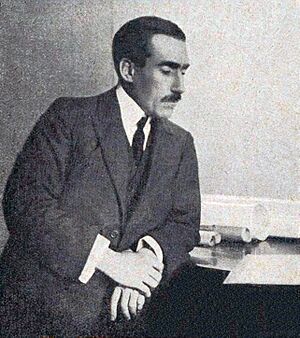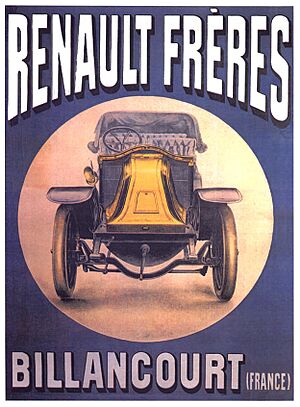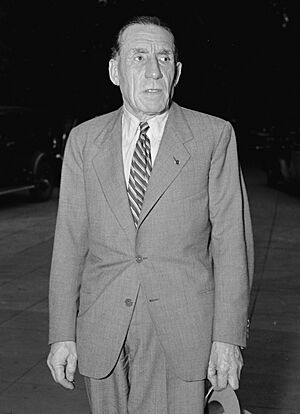Louis Renault (industrialist) facts for kids
Quick facts for kids
Louis Renault
|
|
|---|---|
 |
|
| Born | 12 February 1877 Paris, France
|
| Died | 24 October 1944 (aged 67) Fresnes Prison, Fresnes, France
|
| Nationality | French |
| Occupation | Business |
| Known for | co-founder of Renault |
| Relatives | Marcel Renault and Fernand Renault |
| Awards | Legion of Honor |
Louis Renault (French: [lwi ʁəno]; February 12, 1877 – October 24, 1944) was a French inventor and businessman. He was one of the people who started the famous car company, Renault. He was also a very important person in the early days of the automobile industry.
Renault built one of France's biggest car companies, which still uses his name today. During World War I, his factories helped a lot with the war effort. They famously made the first modern tank, called the Renault FT tank.
Later, during World War II, he was accused of working with the Germans. He died in prison in France in 1944, while waiting for his trial. After his death, his company was taken over by the French government.
Contents
Early Life and First Car
Louis Renault was the fourth of six children. He grew up in a well-off family in Paris, France. From a young age, Louis loved engineering and mechanics. He spent many hours working on engines and learning how things were built.
In 1898, he built his very first car. He used a used 3⁄4 hp (560 W) De Dion-Bouton engine and added his own inventions. His car had a special driveshaft and a three-speed gearbox with reverse. He patented this gearbox a year later.
Louis called his car the Voiturette. On December 24, 1898, he made a bet with friends. He said his car could drive up the steep Rue Lepic in Montmartre. He won the bet, and people were so impressed that he received 13 orders for his new car!
Starting the Renault Company
Seeing how popular his car was, Louis decided to start a business. He teamed up with his two older brothers, Marcel and Fernand. They had experience in business from their father's company.
They officially formed the Renault Frères (Renault Brothers) company on February 25, 1899. At first, Louis focused on designing and building the cars. His older brothers handled the business side.
Sadly, Marcel died in a car race in 1903. Then, in 1908, Fernand retired due to health problems and passed away in 1909. After this, Louis Renault took full control of the company.
Louis Renault's Family Life
On September 26, 1918, Louis Renault married Christiane Boullaire. She was 21 years old, and he was 40. They had one son, Jean-Louis, who was born in 1920.
The family had homes in Paris and a large country estate. This estate was near Rouen and was called Chateau Herqueville. It was a very big property, covering about 4,000 hectares.
Renault's Role in World War I
When World War I began in August 1914, there was a big need for artillery shells. Louis Renault suggested that car factories, like his own, could make these shells quickly. This helped France get the ammunition it needed.
After the war, Louis Renault received a high honor, the Grand Cross of the Légion d'honneur. This was for the huge help his factories gave to the war effort.
One of Renault's most important contributions was the Renault FT tank. He personally designed this revolutionary tank with Rodolphe Ernst-Metzmaier. His factories mass-produced it in 1918, and it was very effective in the war.
Between the World Wars
In the years between World War I and World War II, the Renault company grew very fast. Louis Renault stayed in charge and continued to invent new things. Many of his inventions are still used today. These include hydraulic shock absorbers, modern drum brakes, and compressed gas ignition.
During this time, Renault faced challenges with his workers. He became very focused on his company and its growth. He also became worried about the rise of certain political ideas and labor unions. He eventually spent more time at his country estate.
World War II and Later Years
In 1940, when Germany invaded France, Louis Renault was in the United States. He had been sent by the French government to ask for tanks. When he returned, France had signed an agreement with Germany.
Renault had to decide whether to cooperate with the Germans. If he didn't, his factory and equipment might be moved to Germany. He decided to keep his factories running under the new French government, which meant he was also helping the Germans. Over four years, Renault's factories made many vehicles for the Germans.
Louis Renault said that by keeping his factories open, he saved thousands of workers from being sent to Germany. However, some people saw his actions as helping the enemy.
During the German occupation, the Renault factories were controlled by Germans. The factories became targets for British bombers and were badly damaged in 1942.
Three weeks after France was freed in 1944, Louis Renault was arrested. He was accused of working with Nazi Germany. He denied the charges, saying he kept his factory running to protect it and his workers. He was already very sick when he was arrested.
Louis Renault died on October 24, 1944, while still in prison and waiting for his trial. He was buried at his country home, Chateau Herqueville.
The Company After His Death
In October 1944, the French government took control of Louis Renault's company. On January 1, 1945, four months after Louis Renault's death, the government officially nationalized (took over) his company. It was given a new name: Régie Nationale des Usines Renault (RNUR).
So, the company Louis Renault created became a government-owned company. This happened because he was accused of helping the enemy during the war, even though he died before he could be tried.
See also
 In Spanish: Louis Renault (industrial) para niños
In Spanish: Louis Renault (industrial) para niños




